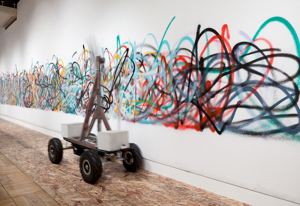Although this photo was not taken by me personally, I thought that it should be shown as it portrays the debate that is commonly had over the use of graffiti. The picture was posted on the news, revealing a brand new invention coined “Graffiti Bot.” Showcased in an art gallery, the robot glides along the wall using various colours to paint “graffiti,” or rather, random scribbles, onto the canvas.
But can this be considered graffiti? Can a robot, programmed simply to paint be considered as creating graffiti? Or must graffiti have a motive – some kind of statement?
In Jeff Ferell’s book, “Crime of Style: Urban Graffiti and the Politics of Criminality,” he describes graffiti as a medium through which different meanings are portrayed. Specifically, in his case study of Denver, Ferell situates graffiti in relation to marginalized individuals, and even goes so far as to say that individuals participating in graffiti “participate in a process rooted in young black cultural,” (Ferell, 1993). Ultimately, he portrays the idea that graffiti is not just paint applied to a surface, rather it is the message that lies within the process that is important, and which links individuals within a larger culture of conversation. For some marginalized individuals, graffiti is a way to anonymously create a statement that reaches the larger public, giving a voice to those who often go unheard.
In contrast to this message, the photo above portrays how the dominant society appropriates this medium of communication and controversy, and devalues it to a simple process of applying paint to a surface. By reducing the art form to a simple computer program, devoid of human feeling, the meaning and culture traditionally behind graffiti is lost.
By: Natalie Adams
Bibliography:
Ferell, Jeff. (1993). Crimes of Style: Urban Graffiti and The Politics of Criminality
Graffiti Bot Photo. (2011). <http://hackaday.com/2011/11/17/double-pendulum-spray-gives-this-graffiti-bot-some-style/>. Accessed Feb. 8th, 2012.

